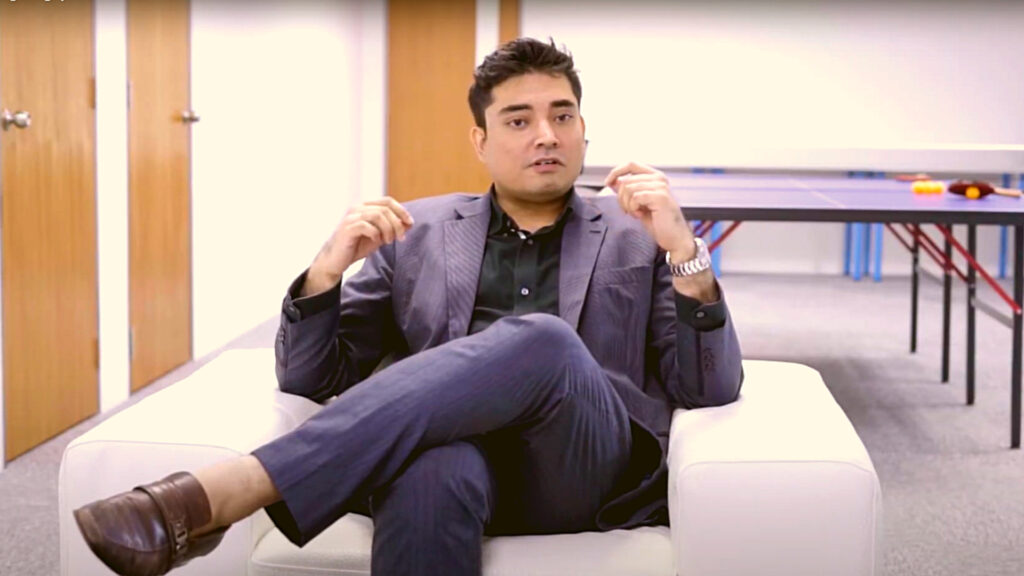Sancy Suraj is a name synonymous with memory records and feats. He is a Singaporean memory coach and athlete who has repeatedly showcased his skills on various platforms. His most recent accomplishment was setting the record for the Fastest Time To Identify All Capital Cities, identifying all 197 capital cities in just 7 minutes and 39 seconds. This article aims to explore Sancy Suraj’s use of the mind palace technique to memorize large amounts of information and his contribution to raising awareness about the power of memory strategies.

What is the “mind palace” technique that Sancy Suraj uses to memorize large amounts of information, and how did he develop his expertise in this area?
The “”mind palace”” technique, also known as the method of loci, is a memory technique that involves associating information with a familiar location, such as a building or a room. This technique allows me to mentally place pieces of information in different locations throughout the “”palace,”” and then recall them later by mentally walking through the location and retrieving the information I need.
I first learned about this technique when I was studying for my exams in college. I was struggling to remember all of the information I needed to know, and I came across a book that explained the method of loci. I was skeptical at first, but I decided to give it a try. I found that it was an incredibly effective way to memorize large amounts of information quickly and accurately.
To develop my expertise in this area, I spent countless hours practicing and refining my technique. I would create mental palaces for different types of information, such as lists of words or numbers, historical dates, or even entire speeches. I would also challenge myself to memorize increasingly complex information, such as the names of all the capital cities in the world.
Over time, I developed a deep understanding of how the mind palace technique works and how to apply it effectively to different types of information. I also honed my ability to visualize and recall information quickly, which is essential for achieving record-breaking memory feats like my capital city recall record. Overall, I believe that my expertise in the mind palace technique is a result of years of dedicated practice and a deep passion for unlocking the full potential of the human mind.
How does Sancy Suraj apply the mind palace technique specifically to memorize the names and locations of capital cities around the world?
To memorize the names and locations of capital cities around the world, I use a specific version of the mind palace technique that I have developed over years of practice. I start by creating a mental palace that includes a series of rooms, each of which represents a different continent. Then, within each room, I place mental markers that represent specific countries, and within each country, I place mental markers that represent specific capital cities.
For example, in the room that represents Asia, I might place a mental marker for China, and within that marker, I would place mental markers for Beijing, Shanghai, and other major cities. By associating each capital city with a specific mental marker and location within my mental palace, I can quickly and accurately recall the name and location of each city when needed.
In addition to creating a mental palace, I also use a variety of memory techniques to help me remember the names and locations of each capital city. For example, I might use the “”linking”” technique to connect the name of the city to a visual image that represents that city in some way. This can help me remember the name more easily and recall it quickly when needed.
Finally, I practice my memory recall regularly to ensure that I can quickly and accurately recall the name and location of each capital city. This involves mentally walking through my mental palace and retrieving the information I need, as well as practicing under timed conditions to prepare for record-breaking memory feats.
Overall, the combination of a well-structured mental palace, memory techniques such as linking and visualization, and regular practice and training are the keys to my success in using the mind palace technique to memorize the names and locations of capital cities around the world.
What are some of the benefits of the mind palace technique, and how does it compare to other memory strategies and tricks?
One of the primary benefits of the mind palace technique is its versatility. This technique can be used to memorize a wide variety of information, from lists of words or numbers to entire speeches or presentations. It can also be customized to fit the individual preferences and learning style of the person using it, making it a highly personalized and effective memory strategy.
Another benefit of the mind palace technique is its effectiveness. Studies have shown that this technique can improve memory recall by up to 80%, making it one of the most powerful memory strategies available. This is because the mind palace technique engages multiple areas of the brain, including those responsible for spatial memory, visualization, and attention, which helps to strengthen memory recall over time.
Compared to other memory strategies and tricks, the mind palace technique has several advantages. For example, while mnemonic devices like acronyms or rhymes can be useful for remembering individual pieces of information, they are often limited in their applicability and effectiveness. The mind palace technique, on the other hand, can be used to memorize entire lists or sequences of information in a highly organized and efficient manner.
Similarly, while repetition and rote memorization can be effective for some types of information, they can be time-consuming and require a lot of effort. The mind palace technique, by contrast, allows for more rapid and efficient memory recall, as the information is already organized and stored in a highly accessible mental location.
Overall, the mind palace technique is a highly effective and versatile memory strategy that offers numerous benefits compared to other memory strategies and tricks. By leveraging the power of visualization, spatial memory, and attention, this technique can help individuals to remember large amounts of information quickly and accurately, making it an essential tool for students, professionals, and memory athletes alike.
“The mind palace technique is a powerful and versatile memory strategy that engages multiple areas of the brain to improve memory recall by up to 80%. With its personalized approach and ability to efficiently memorize entire lists and sequences of information, it offers significant advantages over other memory strategies and tricks. It is an essential tool for anyone looking to improve their memory, from students and professionals to memory athletes.”
How has Sancy Suraj’s work as a memory athlete and educator helped to raise awareness about the power of the mind palace technique and other memory strategies?
As a memory athlete and educator, I have made it my mission to raise awareness about the power of the mind palace technique and other memory strategies. Through my record-breaking memory feats and educational efforts, I have shown that anyone can learn to use these techniques to improve their memory recall and achieve their goals.
One way in which I have helped to raise awareness about the mind palace technique and other memory strategies is by sharing my own personal experiences and insights with others. Whether through interviews, presentations, or social media, I have been able to reach a wide audience and show them how powerful these techniques can be.
Another way in which I have helped to raise awareness is by providing training and educational resources to others who are interested in improving their memory. Through my coaching and consulting services, as well as my online courses and tutorials, I have helped countless individuals to learn the mind palace technique and other memory strategies, and to apply them to their personal and professional lives.
Finally, as a record-breaking memory athlete, I have helped to bring attention to the power of the mind palace technique and other memory strategies on a global scale. My achievements have been covered by major media outlets around the world, from Singapore to the United States, and have helped to inspire countless individuals to take up memory training and explore the potential of their own minds.
Overall, through my work as a memory athlete and educator, I have helped to raise awareness about the power of the mind palace technique and other memory strategies, and to inspire individuals around the world to unlock the full potential of their own memories.
What are some of the most impressive records and achievements that Sancy Suraj has earned through his use of the mind palace technique, and how has this impacted his life and career?
As a memory athlete, I have achieved a number of impressive records and accomplishments through my use of the mind palace technique and other memory strategies. Some of my most notable achievements include:
Fastest Time to Identify All Capital Cities: On Pi Day, March 14th, 2021, I set a new Singapore record for the fastest time to identify all 197 capital cities of the world, achieving the feat in just 7 minutes and 39 seconds. This record showcased the power and effectiveness of the mind palace technique and helped to bring more attention to the benefits of memory training.
Most Pi Digits Recited in One Minute: In 2019, I set a new Singapore record for reciting the most digits of pi in one minute, reciting a total of 121 digits. This record was another demonstration of the effectiveness of memory techniques, as I used the Major System to memorize the digits of pi and recite them quickly and accurately.
Multiple Guinness World Records: I have set several Guinness World Records for memory feats, including the fastest time to memorize a deck of shuffled playing cards in Singapore, and the fastest time to identify a series of binary numbers in Singapore.
My achievements as a memory athlete have had a significant impact on my life and career. They have allowed me to showcase my memory abilities to a global audience, and have opened up many new opportunities for me, including coaching and consulting services, as well as speaking engagements and media appearances. Most importantly, however, my achievements have given me a sense of personal satisfaction and accomplishment, and have shown me the power of setting ambitious goals and working hard to achieve them.
“Through the power of memory techniques, I have been able to achieve incredible feats and push the limits of what I thought was possible. My accomplishments as a memory athlete have not only brought me personal satisfaction but have also allowed me to inspire others to reach their own potential and embrace the power of their own minds.”
Sancy Suraj is an expert in using the mind palace technique, a powerful memory strategy that enables the memorization of vast amounts of information through the creation of a mental “”palace.”” He uses this technique to memorize capital cities worldwide, and it has played a crucial role in his multiple memory records. Suraj has honed his expertise through extensive training, and his work as a memory athlete and educator has helped raise awareness about the potential of memory strategies.
The mind palace technique offers several benefits over other memory strategies, such as the ability to retain vast amounts of information for long periods. Sancy Suraj’s accomplishments in memory competitions, including his impressive pi digit recall record of 1,505, highlight the efficacy of the technique. Suraj has trained his mind and body to perform at the highest levels during memory competitions, focusing on factors such as nutrition, sleep, and mental preparation.
Sancy Suraj’s expertise in the mind palace technique extends beyond his personal accomplishments. He has dedicated himself to helping others, including students, educators, and business professionals, to improve their memory skills. Suraj’s approach aligns with broader trends in fields like cognitive psychology, neuroscience, and education, and he has addressed common mistakes that people make when trying to improve their memory and learning skills.

How does Sancy Suraj train his mind and body to perform at the highest levels during memory competitions, and what are some of the key factors that contribute to his success?
As a memory athlete, I take both my mental and physical training seriously. To perform at the highest levels during memory competitions, I employ a number of strategies to prepare my mind and body.
Mental Training:
One of the most important things I do to train my mind is to use mnemonic techniques like the mind palace to memorize large amounts of information. This involves creating vivid and memorable mental images and placing them in a familiar location, like a palace or house. I practice this technique regularly, using it to memorize everything from numbers and letters to lists of words and names.
Another key factor in my mental training is regular practice and repetition. Just like with any skill, the more I practice, the better I become. I use various drills and exercises to keep my memory sharp, and I also use visualization and meditation techniques to stay focused and calm during competitions.
Physical Training:
In addition to mental training, I also take steps to keep my body in top condition. This includes regular exercise, which I find helps to reduce stress and improve my overall cognitive function. I also pay attention to my diet, making sure to eat a healthy and balanced diet that is rich in brain-boosting nutrients like omega-3 fatty acids, vitamins, and antioxidants.
Key Factors for Success:
There are several key factors that have contributed to my success as a memory athlete. One of the most important is persistence and dedication. Memory training is not easy, and it takes a lot of hard work and practice to see real improvements. I have also learned to set achievable goals and break them down into manageable steps, which helps to keep me motivated and focused.
Another important factor is attention to detail. Memory competitions often involve memorizing large amounts of information quickly and accurately, so even small mistakes can be costly. I have learned to be meticulous in my preparation and to double-check my work to minimize errors.
Finally, a positive mindset and a willingness to take risks have also been important factors in my success. I approach every competition with a sense of excitement and adventure, and I am always looking for new and innovative ways to improve my performance.
How does Sancy Suraj use his expertise in the mind palace technique to help others, such as students, educators, and business professionals?
As a memory coach and educator, I am passionate about sharing my knowledge of the mind palace technique with others. I believe that anyone can learn to use this powerful mnemonic strategy to improve their memory and achieve their goals.
One way that I use my expertise in the mind palace technique is by working with students. I have developed a number of memory training programs that are specifically designed for students of all ages and abilities. These programs teach students how to use the mind palace technique to memorize everything from vocabulary words and historical facts to mathematical formulas and scientific concepts. By helping students to improve their memory skills, I hope to empower them to succeed in school and beyond.
I also work with educators to help them incorporate memory training into their curricula. I believe that memory training is an essential component of any well-rounded education, and I work with educators to develop customized programs that meet the unique needs of their students. I also provide training and support for educators who want to incorporate memory training into their classrooms, including lesson plans, activities, and resources.
Finally, I work with business professionals to help them improve their memory and cognitive function. Many professionals struggle with information overload, which can lead to stress, burnout, and reduced productivity. By teaching professionals how to use the mind palace technique to improve their memory and focus, I hope to help them work more efficiently and effectively.
Overall, my goal is to help people of all ages and backgrounds to unlock the full potential of their memory and achieve their goals. By sharing my expertise in the mind palace technique, I hope to empower others to improve their memory, boost their cognitive function, and reach their full potential.
What are some of the most common mistakes that people make when trying to improve their memory and learning skills, and how does Sancy Suraj address these issues in his work?
As a memory coach and educator, I have worked with many individuals who are interested in improving their memory and learning skills. Through my work, I have seen several common mistakes that people make when trying to enhance their cognitive abilities.
One of the most common mistakes is trying to memorize information without understanding it. Simply rote memorization without understanding the underlying concepts can lead to superficial and short-lived learning. Instead, it is important to focus on understanding the material, which creates a foundation for long-term retention and recall. I address this issue by teaching my clients how to use the mind palace technique to connect new information with pre-existing knowledge and to visualize concepts in a meaningful way.
Another common mistake is failing to review material regularly. Many individuals cram information into their brains before an exam or presentation, only to forget it shortly afterward. Instead, it is important to review material frequently and consistently over time, which reinforces learning and improves long-term retention. I address this issue by teaching my clients how to use spaced repetition techniques to review information at optimal intervals.
A third common mistake is neglecting the role of sleep, nutrition, and exercise in cognitive function. Sleep deprivation, poor nutrition, and a sedentary lifestyle can all impair cognitive performance, including memory and learning. I address this issue by emphasizing the importance of a healthy lifestyle, including regular exercise, a balanced diet, and adequate sleep, in promoting cognitive function.
Overall, by addressing these common mistakes in my work, I help my clients to improve their memory and learning skills in a meaningful and sustainable way.
How does Sancy Suraj’s approach to memory and learning align with broader trends in fields like cognitive psychology, neuroscience, and education?
As a memory coach and educator, my approach to memory and learning aligns closely with broader trends in fields like cognitive psychology, neuroscience, and education.
Cognitive psychology emphasizes the importance of active engagement with information for effective learning and retention. This is reflected in my teaching of the mind palace technique, which encourages learners to actively visualize and connect information in meaningful ways. I also emphasize the importance of understanding concepts rather than just rote memorization.
Neuroscience has shown that the brain is highly plastic and capable of changing and adapting throughout life. This highlights the importance of ongoing learning and cognitive stimulation for maintaining and improving cognitive function. My approach emphasizes lifelong learning and emphasizes the use of techniques like spaced repetition and deliberate practice to maintain and improve memory and learning skills.
In education, there is a growing recognition of the importance of metacognition, or thinking about one’s own thinking processes, for effective learning. My approach encourages learners to be aware of their own cognitive processes and to use techniques like self-testing and self-explanation to enhance learning and retention.
Overall, my approach to memory and learning aligns closely with broader trends in cognitive psychology, neuroscience, and education, emphasizing active engagement with information, ongoing learning, and metacognitive awareness. By staying up-to-date with these trends and integrating them into my work, I am able to provide my clients with effective and evidence-based techniques for improving their memory and learning skills.
What advice would Sancy Suraj give to someone who wants to start using the mind palace technique or other memory strategies, and how can they begin developing these skills today?
“If someone wants to start using the mind palace technique or other memory strategies, the first piece of advice I would give them is to start small and build gradually. It can be overwhelming to try to memorize large amounts of information all at once, so start with something simple like a grocery list or a short poem. Once you get the hang of it, you can gradually increase the amount of information you’re trying to remember.
Another important tip is to make sure you’re engaging all of your senses when you’re trying to memorize something. This means using visual, auditory, and even olfactory cues to help anchor the information in your mind. For example, when I’m trying to memorize a list of capital cities, I might create a vivid mental image of each city in my mind’s eye and also associate a specific sound or smell with each one.
Practice is also key. The more you practice using memory techniques, the more effective they will become. Set aside a few minutes each day to work on memorizing something using the mind palace technique or other memory strategies, and try to be consistent with your practice.
Finally, it’s important to stay motivated and keep challenging yourself. Set goals for yourself and work towards them, whether it’s memorizing a certain number of digits of pi or mastering the names of all the countries in the world. Don’t be afraid to push yourself out of your comfort zone and try new things.
Overall, developing strong memory and learning skills takes time, practice, and dedication, but it’s a skill that anyone can learn with the right mindset and approach. By starting small, engaging all of your senses, practicing consistently, and staying motivated, you can begin to develop a powerful memory that will serve you well in all aspects of your life.”
“Developing a strong memory is not an innate talent, but a skill that can be learned with consistent practice and dedication. By starting small, engaging all your senses, and challenging yourself with new goals, you can unlock the full potential of your memory using techniques such as the mind palace. Remember, every journey begins with a single step, so start today and watch your memory skills grow.”
Sancy Suraj’s accomplishments in memory records and his contribution to raising awareness about memory strategies make him an inspiring figure. His use of the mind palace technique to memorize vast amounts of information is a testament to the potential of memory strategies. By sharing his expertise and experience, Sancy Suraj is helping others to develop their memory skills and achieve their goals.
















